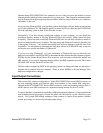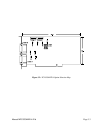
Page 5-3
Manual MPCICOM422-4.E1b
The C command to set the UART for an 8-bit word, no parity, and one stop bit is:
outportb(BASEADDR +3, 0x03)
The final initialization step is to flush the receiver buffers. You do this with two reads from the
receiver buffer at Base Address +0. When done, the UART is ready to use.
Reception
Reception can be handled in two ways: polling and interrupt-driven. When polling, reception is
accomplished by constantly reading the Line Status Register at Base Address +5. Bit 0 of this register
is set high whenever data are ready to be read from the chip. A simple polling loop must continuously
check this bit and read in data as it becomes available. The following code fragment implements a
polling loop and uses a value of 13, (ASCII Carriage Return) as an end-of-transmission marker:
do
{
while (!(inportb(BASEADDR +5) & 1)); /*Wait until data ready*/
data[i++]= inportb(BASEADDR);
}
while (data[i]!=13); /*Reads the line until null character rec'd*/
Interrupt-driven communications should be used whenever possible and is required for high data rates.
Writing an interrupt-driven receiver is not much more complex than writing a polled receiver but care
should be taken when installing or removing your interrupt handler to avoid writing the wrong
interrupt, disabling the wrong interrupt, or turning interrupts off for too long a period.
The handler would first read the Interrupt Identification Register at Base Address +2. If the interrupt
is for Received Data Available, the handler then reads the data. If no interrupt is pending, control exits
the routine. A sample handler, written in C, is as follows:
readback = inportb(BASEADDR +2);
if (readback & 4) /*Readback will be set to 4 if data are available*/
data[i++]=inportb(BASEADDR);
outportb(0x20,0x20); /*Write EOI to 8259 Interrupt Controller*/
return;


















